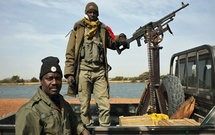 Jihadist resistance against French and African intervention forces in Mali has evolved into a guerilla-style insurgency over the past week, as demonstrated in a string of recent attacks and ambushes around the city of Gao and in the northern mountains.
Jihadist resistance against French and African intervention forces in Mali has evolved into a guerilla-style insurgency over the past week, as demonstrated in a string of recent attacks and ambushes around the city of Gao and in the northern mountains.
Since beginning operations in the country in early January, French troops have retaken several urban jihadist strongholds, facing relatively minimal resistance along the way. Now, France is ostensibly preparing to hand over the main elements of the operation to African forces. But the emergence of insurgent tactics, the difficulty of uprooting jihadists from their northern mountainous redoubts and possible complications with Tuareg factions highlight the serious challenges of stabilizing Mali that remain.
On Feb. 8, a reportedly Tuareg suicide bomber on a motorcycle attacked a Malian army checkpoint in Bourem, a city north of Gao -- the first-ever recorded suicide attack in Mali. The next morning, two young men, reportedly members of Movement for Unity and Jihad in West Africa, an al Qaeda in the Islamic Maghreb affiliate, were arrested at the same checkpoint while carrying explosives. That evening, Malian troops engaged in a firefight at the checkpoint with a small group of militants, one of whom was wearing an explosives belt and tried to flank the post. On Feb. 10, jihadists circumvented checkpoints outside Gao by crossing the Niger River in small boats and entering the city from the water, with a goal of retaking a police station they had used as a base before the French liberated the city in late January. An ensuing firefight in the center of the city lasted for hours until a French combat helicopter flattened a building held by the militants, while Malian forces conducted door-to-door sweeps to secure the surrounding areas.
Keys to Jihadist Success
Jihadist elements can execute attacks like these because they still have access to a considerable amount of territory. Since launching the intervention Jan. 11, French and African forces have focused on retaking population centers, such as Gao, Kidal and Timbuktu, leaving several roads and large swaths of desert unsecure. The intensity and success of such attacks will vary, but the capabilities of the militants could improve over time, and effective networks designed to support insurgent attacks could develop. In contrast, the insurgency will be less robust if interdiction efforts aimed to disrupt jihadist supply lines or finances are successful.
The jihadists will be more difficult to dislodge from their core territory in the Tigharghar Mountains of Mali's northeastern Kidal region, where militants have had time to prepare their defenses. Already, fighting in the region appears to be taking place. On Feb. 5, a contingent of Chadian soldiers and French special operations forces reportedly were ambushed north of Kidal with small arms fire and improvised explosive devices, leaving 24 Chadian troops dead and 11 wounded. If the reports are true, the attack highlights the militants' tactical skills and considerable territorial advantage in the region, as well as the limited abilities of the French and African forces to project force there -- at least in the nooks of the mountainous terrain. Elsewhere in the north, several Malian army and civilian vehicles have been hit by hidden roadside explosives in recent weeks.
These attacks also demonstrate that the jihadist groups active in Mali, especially the Movement for Unity and Jihad in West Africa, have morphed from conventional fighting forces into guerilla-style insurgent groups. The French anticipated this. The training provided by them and other foreign forces, such as European advisers expected to arrive in the coming weeks, will likely emphasize defensive tactics designed to mitigate guerilla attacks.
France Expands its Reach
Meanwhile, France has pulled its conventional ground forces out of Timbuktu, leaving an unclear number of special operations forces behind. The town, which was previously controlled primarily by al Qaeda in the Islamic Maghreb and Ansar Dine, another jihadist group, has not suffered any threats or attacks since then.
France also is expanding its reach farther north. Overnight on Feb. 7, French special operations forces parachuted into Tessalit, a town north of Kidal near Algeria and on the edge of the Igharghar Mountains. The troops secured the town's airfield before being reinforced by paratroopers and a light armored company, which moved some 500 kilometers (310 miles) overnight on the road from Gao. French engineers were also dropped into Tessalit to clear the airport's runway, since withdrawing jihadists have been littering hardened runways with rubble to prevent their use by intervening forces.
A separate contingent of French and Malian forces has moved east from Gao to the town of Menaka, near the border with Niger. An incident occurred there Feb. 12 when Malian troops led by Elhadj Ag Gamou, a Tuareg militia commander who has remained loyal to the Malian government, arrested a local leader of the National Movement for the Liberation of Azawad, the Tuareg separatist group that succeeded in capturing much of northern Mali in March 2012. France has been coordinating with the separatist group, mainly in the region north of Kidal, so the incident risks sparking violence between the group and the French and African forces. France needs to carefully balance the interests and support of the Malian military with those of the Tuaregs to complete its mission and achieve some degree of stability in northern Mali.
More broadly, a sort of battle of wills between the French and the jihadists will likely take place, with neither side willing to leave the Malian theater. The jihadists lack suitable alternative sanctuaries. The French -- aware that any force that remains to quell the insurgency will need to be heavily backed by western financing and training -- know that it would be premature to abandon its Malian and African partners.
Courtesy : Stratfor (www.stratfor.com)